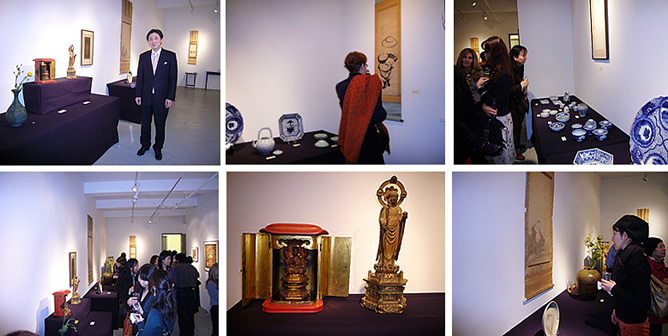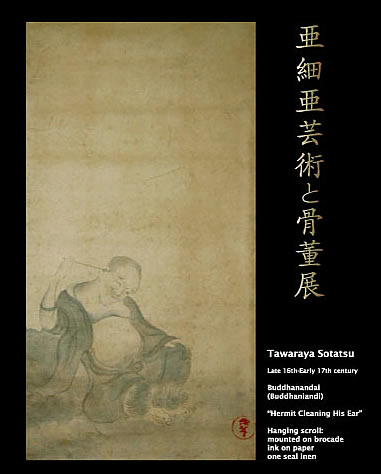Asian Art and Antique
- Let There Be Antique ! -
Curated by Ryo Iida, Asian Art
NY Coo Gallery in March presents its first-ever antique exhibition entitled hAsian Art and Antique | Let There be Antique!h
Curated by Ryo Iida Asian Art, the exhibition features a wide range of Japanese antiques that are both visual and artistic treasure. Two of the most significant works on display are gBuddhanandai,h a sumi-e painting by Tawaraya Sotatsu (1600? ~1640?), and Karatsu-zara (Karatsu Ware Plate) from the mid Edo period. Other works include Imari Ware from the late Edo period and a statue of Buddha (mid 18th century) as well as a magnificent screen depicting a scene of hanami, a cherry blossom festival (late 18th century).
While details of his life including birth/death dates remain mystery, Tawaraya Sotatsu, one of the most prolific painters of the Edo period, was a well-recognized figure already in his time. He had a workshop called gTawarayah where he produced paintings for screens, lantern shades, shikishi boards and tanzaku paper. His reputation and name found admirers in upper crust of society, including the Imperial Family. He went on to become a co-founder of Rimpa School of Japanese Painting, producing such masterpiece as gFujin (Wind God) and Raijin (Thunder God)h screen painting.
A must-see for Sotatsu collectors and fans is gBuddhanandai,h an animated depiction of sennin, an immortal mountain wizard, cleaning his ear. There is no other Sotatsu painting with such offbeat theme, making gBuddhanandaih one of the rarest of all Sotatsu paintings. The dark-light contrast, created by a technique Sotatsu invented called tarashikomi, in which colors are blended by applying one over another that is not yet dry, brings mythological air to the painting.
After the arrival of pottery techniques from Korean peninsula during the Azuchi Momoyama period, Karatsu became renowned for its high quality ceramics. About the same time when tea ceremony was rapidly taking shape as an art form, Karatsu was earning reputation as the producers of the most treasured tea ceramics. The mysterious profundity and Japanese simplicity of Karatsu tea ceramics perfectly compliment the concept of wabicha, or gpoverty tea,h which, when compared to conventional tea ceremony, featured smaller settings, less emphasis on display, and more intimate interactions between the host and the guests.
Karatsu-zara on display likely was used as a tea ware in the early Edo period.@The image of birds flying over reeds, combined with earth-colored surface, evokes the spirit of wabi-sabi, which, according to a Japanese architect Tadao Ando, represents the gJapanese view of life embraced a simpleaesthetic that grew stronger as inessentials were eliminated and trimmed away.h
***************************
RYO IIDA
An expert art dealer specialized in Japanese/Korean art.
After graduating from Hawaii University with a degree in sociology, Iida returned to Tokyo to work for Setsugaboudo, one of Japanfs top antique Asian art dealers. Between 1993 and 2001, Iida worked for Sothebyfs New York where, as the director of both Japanese and Korean art divisions, handled two auctions for each division. After working for Koichi Yanagi Oriental Fine Art, Iida established Ryo Iida Asian Art specialized in ceramics, porcelain, paintings, Buddhist art, lacquer ware and screens. In addition to regular exhibitions, Iida has curated for special exhibitions including gSuiboku-ga Exhibitionh (March, 2005), gKitaoji Rosannjinn Exhibitionh (September, 2005) and gKaiseki and Japanese Porcelainh (September, 2006) at Scholten Japanese Art.
***************************
NY Coo Gallery
------------------------------------------------------- News Letter -------------------------------------------------------
The Opening reception for wAsian Art and Antiquex "Let There Be Antique!"
held on the evening of Friday, March 7th.
Many at the reception said that they felt "healing energy" radiating from antiques.
Please visit our gallery and experience it yourself.
The exhibition run through March 22nd (Sat).

|


